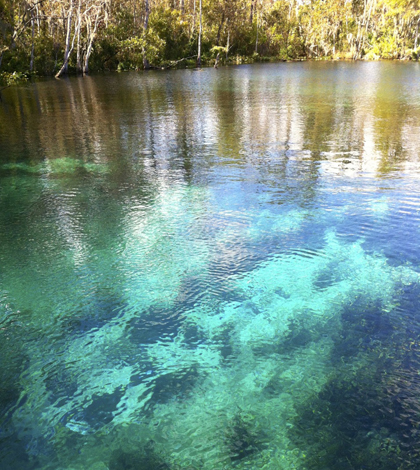Silver Springs, where flows are down and nutrients are up, provide outdoor classroom

The crystal-clear water of the Silver River (Credit: John Hare)
A hundred years before Disney World, tourists flocked to Florida to see the crystal clear water flowing from the Silver Springs, one of the largest artesian spring systems in the world. Thousands of years before that, the springs’ supply of freshwater and food supported early indigenous settlements.
Today, the springs and the Silver River that they feed into are suffering from nutrient pollution and reduced flows brought on by Florida’s population growth and agricultural production.
Those problems have coated the river’s bed with algae and cost the system its place as the highest-volume springs in the world. But the issues have also spurred engagement from students from Vanguard High School in nearby Ocala, where a chemistry class is monitoring the river and gaining some of their first experiences in environmental science and civic participation.
“Our students are getting way more than they bargained for from a chemistry class these days,” said John Hare, who teaches chemistry at Vanguard.
Students participating in the school’s International Baccalaureate curriculum visit the Silver River four times a year to draw water samples. They test the samples with a YSI 9500 photometer to measure parameters such as alkalinity, turbidity, pH, chloride, sulfate and nitrate. The students are working with a local advocacy group to build a database of long term data on the river.
Though Hare said their collection methods fall short of the requirements necessary for research-quality data, their results generally compare favorably with data from a nearby certified lab. Meanwhile, it’s educational experience that comes close to duplicating the work they’ll be doing if they continue on to degree programs or careers in environmental science.
“It’s been a terrific experience for the students,” Hare said. “They all become passionate about what’s happening to Silver Springs and the Silver River.”
Two of the students now sit on the board of the non-profit Silver Springs Alliance, which hosts educational events and activities.
“It’s become better understood in the community at large about how this iconic Silver Springs system of ours is endangered and needs to be protected and restored,” Hare said.
Hare said the advocacy around restoring the springs is “reaching a crescendo,” comparing it to the calls over the last decade to repair the degradation of the Everglades in the southern part of the state.
“We think this is every bit as famous and important as the Everglades, but we’re still at a point where we can prevent the extent of damage that happened in the Everglades,” Hare said. “We’re seeing more progressive views on all sides of the political scene that this must be done for Florida’s future, both in terms of tourism and drinking water and irrigation water.”
Top image: The crystal-clear water of the Silver River (Credit: John Hare)




0 comments